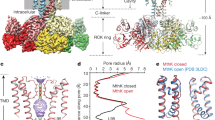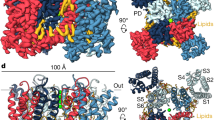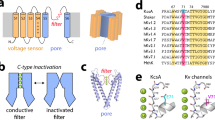Abstract
The electrical signalling properties of neurons originate largely from the gating properties of their ion channels. N-type inactivation of voltage-gated potassium (Kv) channels is the best-understood gating transition in ion channels, and occurs by a 'ball-and-chain' type mechanism. In this mechanism an N-terminal domain (inactivation gate), which is tethered to the cytoplasmic side of the channel protein by a protease-cleavable chain, binds to its receptor at the inner vestibule of the channel, thereby physically blocking the pore1,2. Even when synthesized as a peptide, ball domains restore inactivation in Kv channels whose inactivation domains have been deleted2,3. Using high-resolution nuclear magnetic resonance (NMR) spectroscopy, we analysed the three-dimensional structure of the ball peptides from two rapidly inactivating mammalian Kv channels (Raw3 (Kv3.4) and RCK4 (Kvl.4)). The inactivation peptide of Raw3 (Raw3-IP) has a compact structure that exposes two phosphorylation sites and allows the formation of an intramolecular disulphide bridge between two spatially close cysteine residues. Raw3-IP exhibits a characteristic surface charge pattern with a positively charged, a hydrophobic, and a negatively charged region. The RCK4 inactivation peptide (RCK4-IP) shows a similar spatial distribution of charged and uncharged regions, but is more flexible and less ordered in its amino-terminal part.
This is a preview of subscription content, access via your institution
Access options
Subscribe to this journal
Receive 51 print issues and online access
$199.00 per year
only $3.90 per issue
Buy this article
- Purchase on Springer Link
- Instant access to full article PDF
Prices may be subject to local taxes which are calculated during checkout
Similar content being viewed by others
References
Hoshi, T., Zagotta, W. N. & Aldrich, R. W. Science 250, 533–538 (1990).
Zagotta, W. N., Hoshi, T. & Aldrich, R. W. Science 250, 568–571 (1990).
Ruppersberg, J. P., Frank, R., Pongs, O. & Stocker, M. Nature 353, 657–660 (1991).
Murrell-Lagnado, R. D. & Aldrich, R. W. J. Gen. Physiol. 102, 949–975 (1993).
Murrell-Lagnado, R. D. & Aldrich, R. W. J. Gen. Physiol. 102, 977–1003 (1993).
Schröter, K. H. et al. FEBS Lett. 278, 211–216 (1991).
Covarrubias, M., Wei, A., Salkoff, L. & Vyas, T. B. Neuron 13, 1403–1412 (1994).
Stephens, G. J. & Robertson, B. J. Physiol. (Lond.) 484, 1–13 (1995).
Stühmer, W. et al. EMBO J. 8, 3235–3244 (1989).
Ruppersberg, J. P. et al. Nature 352, 711–714 (1991).
Ottig, G., Liepinsh, E. & Wüthrich, K. Biochemistry 32, 3571–3582 (1993).
Nicholls, A., Sharp, K. A. & Honig, B. Proteins 11, 281–296 (1991).
Lee, C. W., Aldrich, R. W. & Gierasch, L. M. Biophys. J. 61, 379a (1993).
Fernandez-Ballester, G. et al. Biophys. J. 68, 858–865 (1995).
Frank, R. & Gausepohl, H. Modern Methods in Protein Chemistry (de Gruyter, Berlin, 1988).
Jeener, J. J. Chem. Phys. 71, 4546–4553 (1979).
Auer, W. P., Bartholdi, E. & Ernst, R. R. J. Chem. Phys. 64, 2229–2246 (1976).
Davis, D. G. & Bax, A. J. Am. Chem. Soc. 107, 2820–2821 (1985).
Brünger, A. T. X-PLOR Version 3.1 (Yale Univ., New Haven, 1992).
Nilges, M., Clore, G. M. & Gronenborn, A. M. FEBS Lett. 239, 129–136 (1988).
Kirkpatrick, S., Gelatt, G. C. & Vecchi, M. P. Science 220, 671–680 (1983).
Neidig, K. P. et al. J. Biol. NMR 6, 255–270 (1995).
Koradi, R., Billeter, M. & Wüthrich, K. J. Mol. Graph. 14, 51–55 (1996).
Guy, H. R. & Durell, S. R. Biophys. J. 62, 238–250 (1992).
Author information
Authors and Affiliations
Rights and permissions
About this article
Cite this article
Antz, C., Geyer, M., Fakler, B. et al. NMR structure of inactivation gates from mammalian voltage-dependent potassium channels. Nature 385, 272–275 (1997). https://doi.org/10.1038/385272a0
Received:
Accepted:
Issue Date:
DOI: https://doi.org/10.1038/385272a0
This article is cited by
-
De novo design of tyrosine and serine kinase-driven protein switches
Nature Structural & Molecular Biology (2021)
-
Impact of intracellular hemin on N-type inactivation of voltage-gated K+ channels
Pflügers Archiv - European Journal of Physiology (2020)
-
Modulation of K+ channel N-type inactivation by sulfhydration through hydrogen sulfide and polysulfides
Pflügers Archiv - European Journal of Physiology (2019)
-
1.2 Å X-ray Structure of the Renal Potassium Channel Kv1.3 T1 Domain
The Protein Journal (2013)
-
Structural determinants of Kvβ1.3-induced channel inactivation: a hairpin modulated by PIP2
The EMBO Journal (2008)
Comments
By submitting a comment you agree to abide by our Terms and Community Guidelines. If you find something abusive or that does not comply with our terms or guidelines please flag it as inappropriate.



